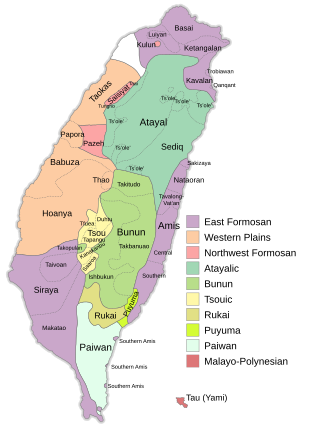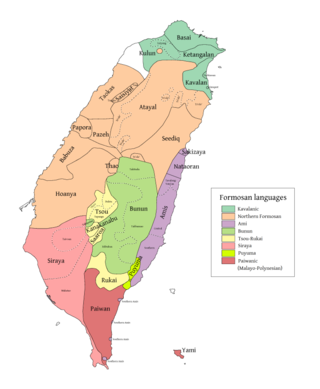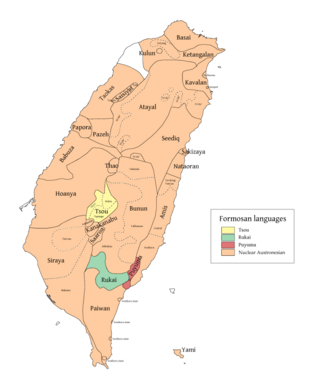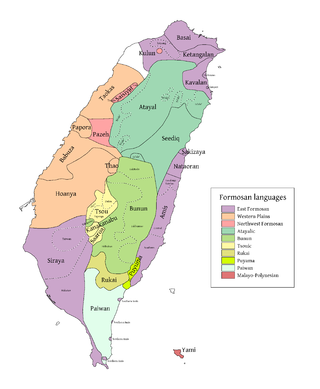The Proto-Austronesian and Proto-Malayo-Polynesian personal pronouns below were reconstructed by Robert Blust. [1]
Proto-Austronesian and Proto-Malayo-Polynesian Pronouns| Type of Pronoun | English | Proto-Austronesian | Proto-Malayo-Polynesian |
|---|
| 1s. | "I" | *i-aku | *i-aku |
| 2s. | "you" | *i-(ka)Su | *i-kahu |
| 3s. | "he/she/it" | *si-ia | *si-ia |
| 1p. (inclusive) | "we (and you)" | *i-(k)ita | *i-(k)ita |
| 1p. (exclusive) | "we (but not you)" | *i-(k)ami | *i-(k)ami |
| 2p. | "you all" | *i-kamu | *i-kamu, ihu |
| 3p. | "they" | *si-ida | *si-ida |
In 2006, Malcolm Ross also proposed seven different pronominal categories for persons. The categories are listed below, with the Proto-Austronesian first person singular ("I") given as examples. [2]
- Neutral (e.g., PAN *i-aku)
- Nominative 1 (e.g., PAN *aku)
- Nominative 2 (e.g., PAN *=ku, *[S]aku)
- Accusative (e.g., PAN *i-ak-ən)
- Genitive 1 (e.g., PAN *=[a]ku)
- Genitive 2 (e.g., PAN *(=)m-aku)
- Genitive 3 (e.g., PAN *n-aku)
The following is from Ross' 2002 proposal of the Proto-Austronesian pronominal system, which contains five categories, including the free (i.e., independent or unattached), free polite, and three genitive categories.
Proto-Austronesian Personal Pronouns | Free | Free polite | Genitive 1 | Genitive 2 | Genitive 3 |
|---|
| 1s. | *[i-]aku | - | *=ku | *maku | *n-aku |
|---|
| 2s. | *[i-]Su | *[i-]ka-Su | *=Su | *miSu | *ni-Su |
|---|
| 3s. | *s(i)-ia | - | (*=ia) | - | *n(i)-ia |
|---|
| 1p. (excl.) | *i-ami | *[i-]k-ami | *=mi | *mami | *n(i)-ami |
|---|
| 1p. (incl.) | *([i])ita | *[i-]k-ita | *=ta | *mita | *n-ita |
|---|
| 2p. | *i-amu | *[i-]k-amu | *=mu | *mamu | *n(i)-amu |
|---|
| 3p. | *si-da | - | (*=da) | - | *ni-da |
|---|
Malayo-Polynesian languages
Ilokano personal pronouns distinguish three cases: absolutive, ergative, and oblique. They also distinguish three numbers: singular, dual and plural.
Accent marks in the following table are not written, but given here for pronunciation purposes.
Ilokano Personal Pronouns | Absolutive | Ergative | Oblique |
|---|
| Disjunctive | Enclitic (-ak) [21] | Enclitic (-ko) [22] | Disjunctive |
|---|
| 1st person singular | siák [23] | -ak [24] | -k(o) [25] [26] | kaniák |
|---|
| 1st person dual | datá, sitá [23] | -ta | -ta | kadatá |
|---|
| 2nd person singular | siká [23] | -ka | -m(o) [25] | kenká |
|---|
| 3rd person singular | isú(na) | -Ø [27] | -na | kenkuána |
|---|
| 1st person plural inclusive | datayó, sitayó [23] | -tayó | -tayó | kadatayó |
|---|
| 1st person plural exclusive | dakamí, sikamí [23] | -kamí | -mi | kadakamí |
|---|
| 2nd person plural | dakayó, sikayó [23] | -kayó | -yo | kadakayó |
|---|
| 3rd person plural | isúda | -da | -da | kadakuáda |
|---|
Like nouns, Tagalog personal pronouns are categorized by case. As above, the indirect forms also function as the genitive.
Tagalog Personal Pronouns| | Direct (ang) | Indirect (ng) | Oblique (sa) |
|---|
| 1st person singular | akó | ko | akin |
|---|
| 1st person dual | kitá/kata [28] | nitá/nata [28] | kanitá/kanata (ata) [28] |
|---|
| 1st person plural inclusive | tayo | natin | atin |
|---|
| 1st person plural exclusive | kamí | namin | amin |
|---|
| 2nd person singular | ikáw (ka) | mo | iyó |
|---|
| 2nd person plural | kayó | ninyó | inyó |
|---|
| 3rd person singular | siyá | niyá | kaniyá |
|---|
| 3rd person plural | silá | nilá | kanilá |
|---|
Like nouns, Cebuano personal pronouns are categorized by case.
Cebuano Personal Pronouns| | Kinsa | Tag-iya (primary) | Tag-iya (modifier) | Oblique |
|---|
| 1st person singular | ako | akoa | nako | kanako |
| 2nd person singular | ikaw | imoha | nimo | kanimo |
| 3rd person singular | siya / sya | iyaha /iya | niya | kaniya |
| 1st person plural inclusive | kita | atoa / ato | nato | kanato |
| 1st person plural exclusive | kami | amoa / amo | namo | kanamo |
| 2nd person plural | kamo | inyoha | ninyo | kaninyo |
| 3rd person plural | sila | ilaha | nila | kanila |
*The two sets of tag-iya case function similarly except that the primary tag-iya would need the unifying linker nga and the modifier tag-iya cannot be used as complementary adjective.
**The final syllable of a primary tag-iya pronoun is mostly dropped.
When the pronoun is not the first word of the sentence, the short form is more commonly used than the full form.
Cebuano Enclitic Personal Pronouns| | Kinsa | Tag-iya (primary) | Tag-iya (modifier) | Oblique |
|---|
| 1st person singular | ko | ako | ko | nako |
| 2nd person singular | ka | imo | mo | nimo |
| 3rd person singular | siya | iya | niya | niya |
| 1st person plural inclusive | ta | ato | ta | nato |
| 1st person plural exclusive | mi | amo | namo | namo |
| 2nd person plural | mo | inyo | ninyo | ninyo |
| 3rd person plural | sila | ila | nila | nila |
*When the object is a second person pronoun, use ta instead of ko.
The informal pronouns aku, kamu, engkau, ia, kami, and kita are indigenous to Malay. However, there are more personal pronouns according to formality, see more at Malay grammar.
Malay personal pronouns| Person | Malay | English |
|---|
| First person | saya (standard, polite),
aku (informal, familiar) | I, me |
| kami | we, us: they and me, s/he and me |
| kita | we, us: you and me, you and us |
| Second person | anda (polite, formal),
engkau, kamu (familiar, informal) | you, thou, thee |
anda sekalian (formal),
kalian (informal) | you, y'all |
| Third person | ia ~ dia,
dia orang | he, she, him, her |
ia ~ dia,
mereka, dia orang | they, them |
- Possessive pronouns
Aku, kamu, engkau, and ia have short possessive enclitic forms. All others retain their full forms like other nouns, as does emphatic dia: meja saya, meja kita, meja anda, meja dia "my table, our table, your table, his/her table".
Possessed forms of meja "table"| Pronoun | Enclitic | Possessed form |
|---|
| aku | -ku | mejaku (my table) |
| kamu | -mu | mejamu (your table) |
| engkau | -kau | mejakau (your table) |
| ia | -nya | mejanya (his, her, their table) |
Javanese Personal Pronouns| Person | Javanese | English |
|---|
| First person | aku (standard, informal),
kula (formal),
dalem/kawula (more formal/ humble) | I, me |
dhèwè/awaké dhèwè (informal),
kita (formal) | we, us |
| Second person | kowé (informal),
sampéyan (formal),
panjenengan (more formal) | you |
kowé kabèh (informal),
sampéyan sedaya (formal),
panjenengan sedanten (more formal) | you, you all |
| Third person | dhèwèké/wongé (informal), piyantuné, panjenengané (formal),
panjenenganipun (more formal) | he, she, him, her |
dhèwèké kabèh (informal, but rarely), wong-wong iku (informal)
panjenenganipun sedanten, tiyang-tiyang/piyantun-piyantun puniki (more formal) | they, them |
Javanese lacks some personal pronouns. For the first person plural, Javanese use awaké dhèwè, literally meaning "the body itself" (cf. Malay : badannya sendiri) or just dhèwè, that originally means "itself" or "alone". For the third person singular, Javanese uses dhèwèké that means "itself" (cf. Malay: dirinya), from dhèwè (self, alone) + -k- (archaic glottal stop)+ -(n)é (3rd person possessive enclitic), or wongé' (cf. Malay: orangnya) that means "the person", from wong (person)+ -(n)é (3rd person possessive enclitic, that is also used for demonstrative). The rest of plural pronouns uses words kabèh/sedaya/sedanten, all of them meaning "all" after the singular form.
- Possessive pronouns
Aku, kowé, and dhèwèké have short possessive enclitic forms. All others retain their full forms like other nouns: griyané kula, omahé awaké dhèwè, dalemipun panjenengan "my house (formal), our house (informal), your house (more formal)".
Possessed forms of omah/ griya/ dalem "house"| Pronoun | Enclitic | Possessed form |
|---|
| aku | -ku/-(n)é kula/-ipun dalem | omahku/griyané kula/dalemipun dalem (my house) |
| kowe | -mu/-(n)é sampeyan/-ipun panjenengan | omahmu/griyané sampeyan/dalemipun panjenengan (your house) |
| dhèwèké | -(n)é/-ipun | omahé/griyané/dalemipun (his, her, their house) |
Tongan
The Tongan cardinal pronouns are the main personal pronouns which in Tongan can either be preposed (before the verb) or postposed (after the verb). The first are the normal pronouns, the latter the stressed pronouns, which are also used as reflexive pronouns.
Tongan Personal Pronouns | Position | Singular | Dual | Plural |
|---|
| 1st person | exclusive
(I, we, us) | preposed | u, ou, ku | ma | mau |
|---|
| postposed | au | kimaua | kimautolu |
inclusive
(one, we, us) | preposed | te | ta | tau |
|---|
| postposed | kita | kitaua | kitautolu |
| 2nd person | preposed | ke | mo | mou |
|---|
| postposed | koe | kimoua | kimoutolu |
| 3rd person | preposed | ne | na | nau |
|---|
| postposed | ia | kinaua | kinautolu |
Samoan
Like many Austronesian languages, Samoan has separate words for inclusive and exclusive we, and distinguishes singular, dual, and plural. The root for the inclusive pronoun may occur in the singular, in which case it indicates emotional involvement on the part of the speaker.
Samoan Personal Pronouns | singular | dual | plural |
|---|
| First person exclusive | a‘u, ‘ou | mā‘ua, mā | mātou |
|---|
| First person inclusive | tā | tā‘ua, tā | tātou |
|---|
| Second person | ‘oe, ‘e | ‘oulua | ‘outou, tou |
|---|
| Third person | ia / na | lā‘ua | lātou |
|---|
In formal speech, fuller forms of the roots mā-, tā-, and lā- are ‘imā-, ‘itā-, and ‘ilā-.
Hawaiian
Hawaiian Personal Pronouns | Singular (1) | Dual (2) | Plural (3+) |
|---|
| 1st | 2nd | 3rd | 1st incl. | 1st excl. | 2nd | 3rd | 1st incl. | 1st excl. | 2nd | 3rd |
|---|
| Case | Nominative | au | ʻoe | ia | kāua | māua | ʻolua | lāua | kākou | mākou | ʻoukou | lākou |
|---|
| Genitive | a-class | kaʻu | kāu | kāna | kā kāua | kā māua | kā ʻolua | kā lāua | kā kākou | kā mākou | kā ʻoukou | kā lākou |
|---|
| o-class | koʻu | kou | kōna | kō kāua | kō māua | kō ʻolua | kō lāua | kō kākou | kō mākou | kō ʻoukou | kō lākou |
|---|
| affectionate | kuʻu | kō | Only used in 1st and 2nd person singular. |
|---|
Accusative,
Dative | iaʻu | iā ʻoe | iā ia | iā kāua | iā māua | iā ʻolua | iā lāua | iā kākou | iā mākou | iā ʻoukou | iā lākou |
|---|
The a-class possessive pronouns refer to alienable possession, as with boats, children, clothing, and spouses. The o-class possessive pronouns refer to inalienable (incapable of being begun or ended) possession, as with parents and body parts. [29]

The Austronesian languages are a language family widely spoken throughout Maritime Southeast Asia, parts of Mainland Southeast Asia, Madagascar, the islands of the Pacific Ocean and Taiwan. They are spoken by about 386 million people. This makes it the fifth-largest language family by number of speakers. Major Austronesian languages include Malay, Javanese, Sundanese, Tagalog (Filipino), Malagasy and Cebuano. According to some estimates, the family contains 1,257 languages, which is the second most of any language family.

The Formosan languages are a geographic grouping comprising the languages of the indigenous peoples of Taiwan, all of which are Austronesian. They do not form a single subfamily of Austronesian but rather up to nine separate primary subfamilies. The Taiwanese indigenous peoples recognized by the government are about 2.3% of the island's population. However, only 35% speak their ancestral language, due to centuries of language shift. Of the approximately 26 languages of the Taiwanese indigenous peoples, at least ten are extinct, another four are moribund, and all others are to some degree endangered.
In linguistics, a possessive affix is an affix attached to a noun to indicate its possessor, much in the manner of possessive adjectives.

Basay was a Formosan language spoken around modern-day Taipei in northern Taiwan by the Basay, Qauqaut, and Trobiawan peoples. Trobiawan, Linaw, and Qauqaut were other dialects.

The Bunun language is spoken by the Bunun people of Taiwan. It is one of the Formosan languages, a geographic group of Austronesian languages, and is subdivided in five dialects: Isbukun, Takbunuaz, Takivatan, Takibaka and Takituduh. Isbukun, the dominant dialect, is mainly spoken in the south of Taiwan. Takbunuaz and Takivatan are mainly spoken in the center of the country. Takibaka and Takituduh both are northern dialects. A sixth dialect, Takipulan, became extinct in the 1970s.

Tsou is a divergent Austronesian language spoken by the Tsou people of Taiwan. Tsou is a threatened language; however, this status is uncertain. Its speakers are located in the west-central mountains southeast of the Chiayi/Alishan area in Taiwan.

Rukai is a Formosan language spoken by the Rukai people in Taiwan. It is a member of the Austronesian language family. The Rukai language comprises six dialects, which are Budai, Labuan, Maga, Mantauran, Tanan and Tona. The number of speakers of the six Rukai dialects is estimated to be about 10,000. Some of them are monolingual. There are varying degrees of mutual intelligibility among the Rukai dialects. Rukai is notable for its distinct grammatical voice system among the Formosan languages.

Pazeh and Kaxabu are dialects of an extinct language of the Pazeh and Kaxabu, neighboring Taiwanese indigenous peoples. The language was Formosan, of the Austronesian language family. The last remaining native speaker of the Pazeh dialect died in 2010.
Kanakanavu is a Southern Tsouic language spoken by the Kanakanavu people, an indigenous people of Taiwan. It is a Formosan language of the Austronesian family.

Saaroa or Lhaʼalua is a Southern Tsouic language spoken by the Saaroa (Hla'alua) people, an indigenous people of Taiwan. It is a Formosan language of the Austronesian family.
Proto-Austronesian is a proto-language. It is the reconstructed ancestor of the Austronesian languages, one of the world's major language families. Proto-Austronesian is assumed to have begun to diversify c. 4000 BCE – c. 3500 BCE in Taiwan.

Robert A. Blust was an American linguist who worked in several areas, including historical linguistics, lexicography and ethnology. He was Professor of Linguistics at the University of Hawaiʻi at Mānoa. Blust specialized in the Austronesian languages and made major contributions to the field of Austronesian linguistics.

Siraya is a Formosan language spoken until the end of the 19th century by the indigenous Siraya people of Taiwan, derived from Proto-Siraya. Some scholars believe Taivoan and Makatao are two dialects of Siraya, but now more evidence shows that they should be classified as separate languages.

The Tsouic languages are three Formosan languages, Tsou proper and the Southern languages Kanakanavu and Saaroa. The Southern Tsouic languages of Kanakanavu and Saaroa have the smallest phonemic inventories out of all the Formosan languages, with each language having only 13 consonants and 4 vowels. These two languages are highly endangered, as many Southern Tsouic speakers are shifting to Bunun and Mandarin Chinese.
The Atayalic languages are a group of Formosan languages spoken in northern Taiwan. Robert Blust considers them to form a primary branch within the Austronesian language family, However, Paul Jen-kuei Li groups them into the Northern Formosan branch, which includes the Northwestern Formosan languages.

The East Formosan languages consist of various Formosan languages scattered across Taiwan, including Kavalan, Amis, and the extinct Siraya language. This grouping is supported by both Robert Blust and Paul Jen-kuei Li. Li considers the Siraya-speaking area in the southwestern plains of Taiwan to be the most likely homeland of the East Formosan speakers, where they then spread to the eastern coast of Taiwan and gradually migrated to the area of modern-day Taipei.

The Northern Formosan languages is a proposed grouping of Formosan languages that includes the Atayalic languages, the Western Plains languages, and the Northwest Formosan languages.

Kulon is an extinct language of the Taiwanese aboriginal people that belonged to the Austronesian language family. Very little data is available for Kulon; the primary source is the 60 pages of Tsuchida (1985). Li (2008) follows Tsuchida in linking Kulon with Saisiyat, while Blust (1999) proposes it was more closely related to Pazeh.

Taivoan or Taivuan, is a Formosan language spoken until the end of the 19th century by the indigenous Taivoan people of Taiwan. Taivoan used to be regarded as a dialect of Siraya, but now more evidence has shown that they should be classified as separate languages. The corpora previously regarded as Siraya like the Gospel of St. Matthew and the Notes on Formulary of Christianity translated into "Siraya" by the Dutch people in the 17th century should be in Taivoan majorly.

Sirayaic languages is one of the sub-branches of the Formosan branch, under the Austronesian languages family. Both Blust (1999) and Li (2010) considers Proto-Siraya belongs to East Formosan languages, along with Kavalanic and Amis languages.















